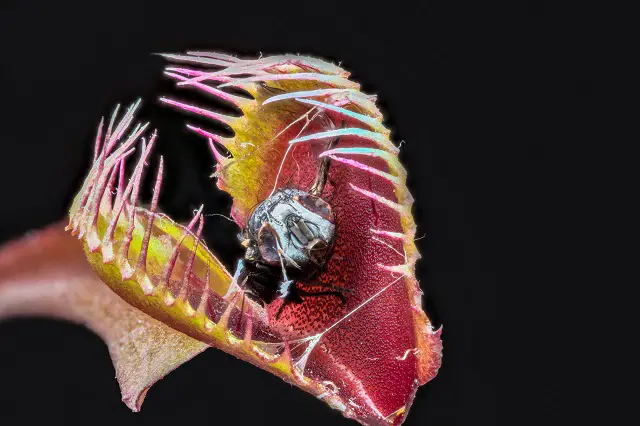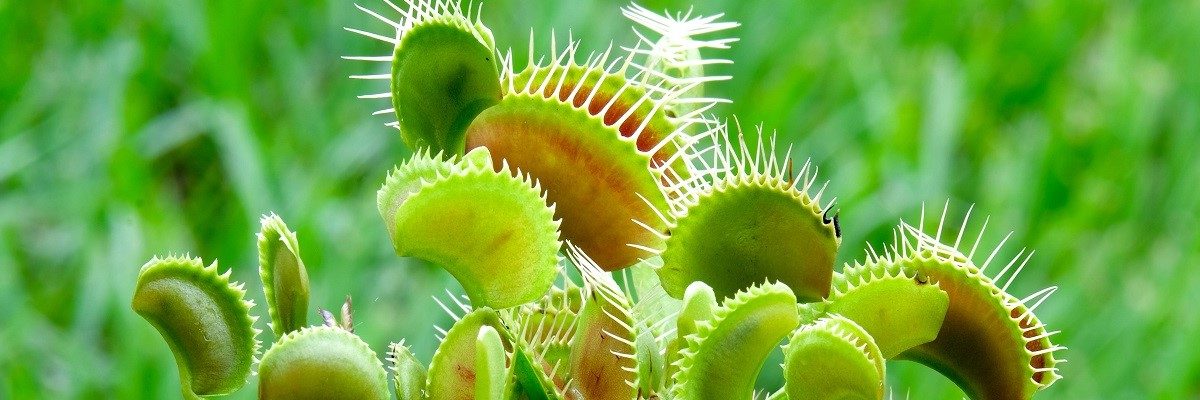Venus flytraps have a slow growth rate. However, when they reach maturity, they can grow as high as twelve inches and about nine inches wide. The traps themselves can grow an inch or more in length. How large a particular Venus flytrap can grow will depend on the variety being grown. You can give your Venus flytrap everything it needs to maximize its growth potential with the right care.
How big can a Venus flytrap get indoors?
Although there are only one species of Venus flytrap, called the Dionaea muscipula, there are multiple cultivated varieties that home gardeners can choose from. These different varieties produce plants of certain colors, sizes, and even mutations.
Depending on the type that you have selected to add to your garden, the height and width of an indoor Venus flytrap can vary. Some varieties of Venus flytrap grow smaller than others, such as the Dionaea ‘Petite Dragon.’ The traps of the Petite Dragon grow just over a half-inch wide.
What is the Largest Venus Flytrap Cultivar?
Considered by many to be the largest Venus flytrap cultivar, the Dionaea B52 can grow traps with a width of 2 ¼ inches. Despite being coined as the largest Venus flytrap cultivar, it surprisingly does not take the trophy for the largest Venus flytrap ever recorded. Nevertheless, it is believed that given the right growing conditions, the Dionaea B25 can not only match that of the largest Venus flytrap on record but exceed it in trap width.
What is the largest Venus flytrap?
Although the Dionaea B52 is considered one of the largest growing varieties of Venus flytraps, the largest grown Venus flytrap ever recorded belongs to the Dionaea ‘Alien’ cultivar.
The Guinness World Records recognized Jeremiah Harris’s Dionaea ‘Alien’ flytrap as having the largest trapping leaf ever recorded. The trapping leaf was recorded as having an impressive width of 2.4 inches.
How do I make my Venus flytrap bigger?
All in all, how big a Venus flytrap grows indoors or outdoors will be a combination of the type of cultivar that it is and how well its living conditions can mimic the ideal environmental factors that allow it to grow to its full potential.
Novice Venus flytrap growers may feel they can make their Venus flytrap grow faster and bigger by adding fertilizer to the soil. Or by feeding insects to multiple traps at a time. This isn’t necessarily the case. When growing a Venus flytrap, it is important to consider its natural habitat.
A closer inspection of their natural habitat and eating habits can help shed light on what exactly they will need to grow to their maximum potential.

Optimal Growing Conditions
Venus flytraps grow naturally in a very small area of the world map. The Venus flytrap’s natural habit is the warm Coastal Plain and Sandhills of South and North Carolina. Below is a closer look at these specific ecosystems.
| Soil Conditions |
|---|
| In nature, they grow among longleaf pine habitats where there is wet or moist soil. |
| The soil where Venus flytraps grow is poor in nutrients. This happens to be why Venus flytraps get their nutrients from eating insects. |
| In the Sandhills area, they grow in transitional areas where the soil is often acidic. |
| They grow where the soil causes water to rise to the surface and provide the plant with water. |
| You can find Venus flytraps growing in sand, where they are right above the water table. |
| Carnivorous Tendencies |
|---|
| Venus flytraps eat ants, spiders, beetles, grasshoppers, and a small number of flying insects. |
| It can go months between meals, taking three to five days for it to digest what they capture. |
| The traps of Venus flytraps can only close a handful of times before they die, and new ones grow. |
How to care for Your Venus flytrap
Below are some gardener tips on how to help your Venus flytrap grow at home.
How to Provide Soil Care
As Venus flytraps grow in nutrient-poor soil, adding things such as fertilizer to their soil can cause a buildup of minerals that will do more harm than good. Instead, you will want to focus on providing your Venus flytrap with moist soil that has excellent drainage.
You can do this by providing it water from below, much as how it gets water in its natural habit. To do this, stand your Venus flytrap’s pot in a dish filled with a centimeter of water.
To keep the soil at ideal conditions and prevent mineral buildup, be sure to water the plant with distilled water. It is even better if you can gather up rainwater and water them with that!
Insect Feeding Frequency
The more you feed your Venus flytrap, doesn’t necessarily mean it will grow bigger faster. As long as its nutrient needs are met, it will continue to grow at its maximum rate (keep in mind they have a slow growth rate as it is).
A Venus flytrap needs to feed insects up to four times a year, with each feeding providing the plant with about three insects.
Provide Adequate Sunlight Exposure
To promote photosynthesis and mimic its natural environment, you will need to make sure your Venus flytrap gets adequate sunlight, placing indoor plants by windows that get the most natural sunlight. Venus flytraps still get energy from the sun despite their carnivorous tendencies. If possible, provide them with 12 hours of full sun.
Keep the Humidity Up
Providing your Venus flytrap with a humid environment, such as growing it in a greenhouse or terrarium, will help keep its soil moist and environment warm.
Allow it to go Dormant in Winter.
Allow your plant to go through its natural growth cycle. If you are providing your Venus flytrap with natural light, it will naturally get less and less sunlight through the winter. If you are using an artificial light source, try to mimic this by turning it on and off to reflect the decrease in daylight hours.
You will also want to water the plant less and trim away any dead leaves.

